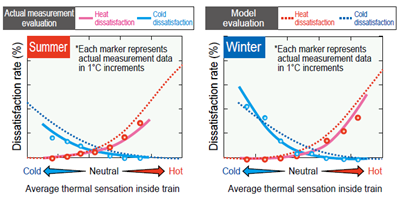26. Thermal Comfort Evaluation Method Using Air Conditioning Log Data from Commuter Trains
Every year, many complaints from passengers about hot or cold conditions inside commuter trains are received. In response, railway operators strive to improve comfort by adjusting set temperatures and conducting actual measurement surveys to understand the conditions. On the other hand, it is difficult to objectively and quantitatively assess how much the overall passenger comfort improves through temperature adjustments, and conducting actual measurement surveys of the thermal environment inside trains requires significant human resources.
Therefore, we proposed a method that utilizes the “air-conditioning log data” from commuter trains accumulated on a daily basis (Figure 1, top) together with the thermal comfort evaluation model we previously developed (Figure 2) that takes into account the characteristics of thermal sensation and individual differences. This approach enables us to objectively and quantitatively assess the overall passenger comfort while capturing the actual thermal environment inside the train, without allocating extensive resources to actual measurement surveys. In the proposed method, inputs such as in-car temperature and humidity, passenger load factor, and outside air temperature recorded in the air-conditioning log data are used to calculate the apparent temperature inside the train, taking into account passengers’ clothing and posture (standing or seated). Based on past experimental data collected inside commuter trains, the method then outputs the proportion of passengers who feel uncomfortably hot or cold (Figure 1, bottom).
A thermal sensation survey was conducted among railway passengers on operating trains (total participants: 74 in summer and 60 in winter), confirming that the proposed method can accurately evaluate passengers’ complaints of feeling too hot or too cold (Figure 3). The proposed method enables year-round evaluation of thermal comfort in commuter trains and can be used to examine measures for improving air conditioning control.



